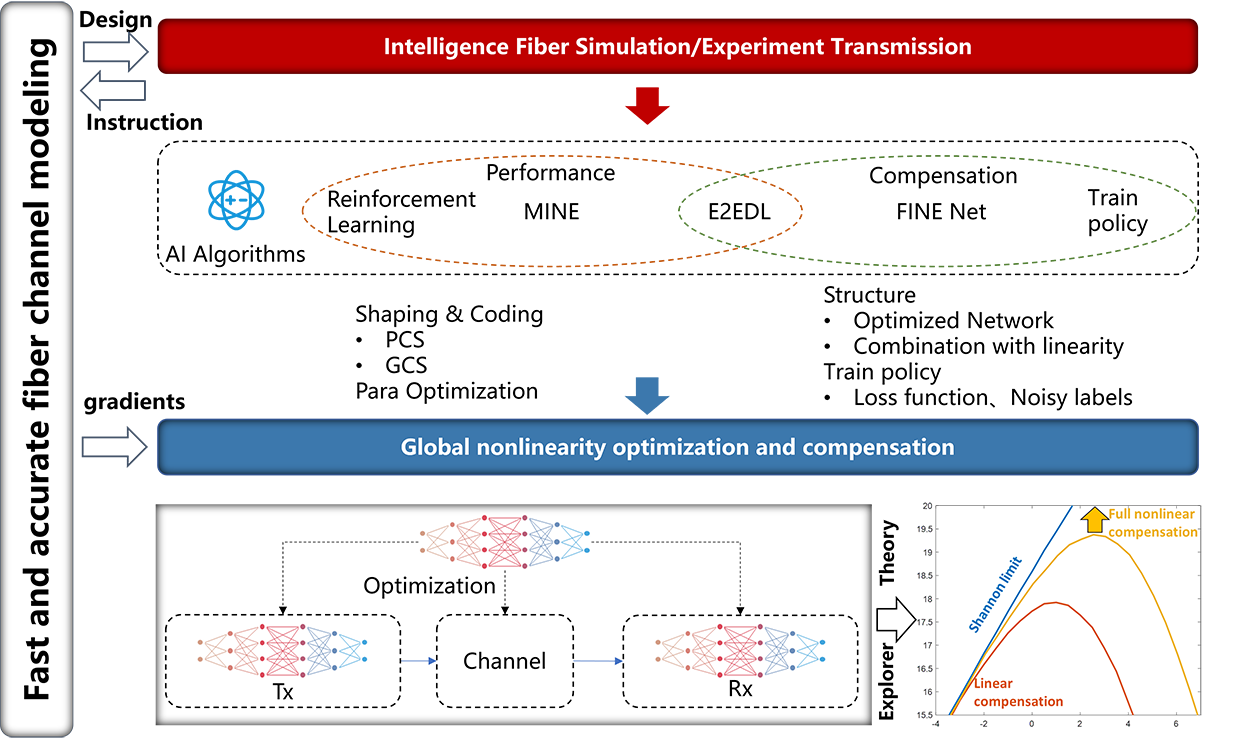Location:Home > Achievement Exhibition >Intelligent Opt...

In modern networks, more than 90% of information is transmitted through optical fibers. According to statistics from relevant organizations, the amount of data transmission is growing rapidly at a rate of 25% per year. This demand drives optical fiber communication to continuously pursue higher transmission rates. In order to pursue higher information transmission efficiency, it is necessary to model and compensate the various effects of the channel. Among them, linear effects (dispersion, attenuation, etc.) have been well compensated in DSP. In long-distance high-speed scenarios, nonlinear effects (mainly Kerr effects) are the main bottlenecks that limit optical signal transmission capabilities, so it is very The linear compensation problem is also called by Huawei as one of the "Top Ten Problems in the ICT Field in the Post-Shannon Era". The main goal of intelligent optical transmission is to establish a high-precision and fast nonlinear channel model, realize accurate compensation and performance optimization of nonlinear effects, and pursue the limit of optical fiber nonlinear capacity.
Both the modeling of fiber channel and the design of nonlinear compensation algorithm rely on the simulation tools of fiber optic communication systems. Matlab is widely used as a simulation tool in academia and industry. In addition to controlled risks, it also has low operating efficiency and long calculation time. It is difficult to be compatible with AI algorithms and other issues. In order to solve the above problems, the intelligent optical transmission team developed a complete fiber optic communication system simulation tool based on the open source Python language, provided a simulation version based on Pytorch, and integrated a variety of neural network algorithms, which enables the simulation platform to perform simulations with the help of GPU and neural networks. Acceleration is naturally compatible with the intelligent algorithm design of optical communication, and on this basis, the global optimization of the transceiver algorithm can be realized. The intelligent optical transmission team focuses on the development of an intelligent modeling and simulation platform for optical fiber communication systems. It is independent, internationally leading, and integrated and open. While supporting its own research, it completes open source code and serves the entire optical communication industry. Based on this open platform, we will jointly carry out research on the innovative architecture and algorithms of optical communication systems with the industry, and jointly break through the core challenge of optical fiber nonlinear channel compensation.
Further, on the basis of realizing fast and accurate modeling of fiber optic channels, the construction of an intelligent simulation and experiment platform for fiber optic transmission is completed. The intelligent optical fiber transmission experiment platform adopts the same algorithm library as the simulation platform, and the simulation and experiment platform realize data alignment and cross-validation. All experimental equipment can be controlled remotely, and the end-to-end nonlinear compensation and global optimization experiments of the optical fiber communication system can be performed by remotely calling the algorithm library. The AI algorithm library includes toolkits such as various general neural networks, reinforcement learning, mutual information estimation network (MINE), fiber nonlinear estimation network (FINE), end-to-end learning, and training strategies. Equalization, nonlinear estimation and compensation at the receiving end, and nonlinear performance optimization combined with the global optimization of the receiving end and the channel, in order to minimize the impact of fiber nonlinearity and achieve the goal of approaching the Shannon capacity limit of the linear channel.

